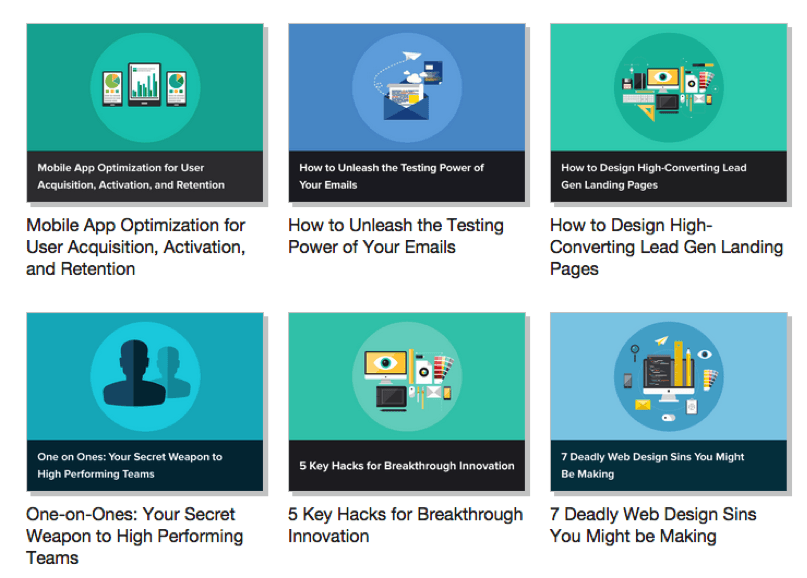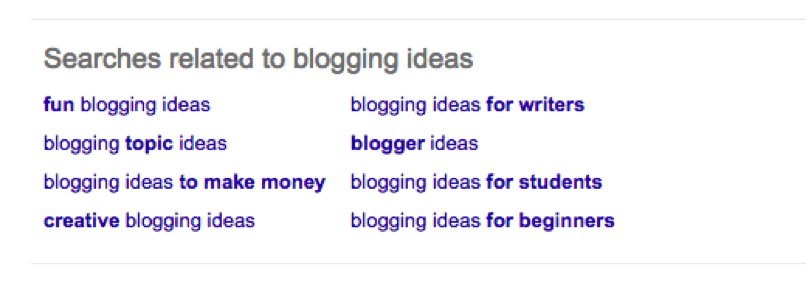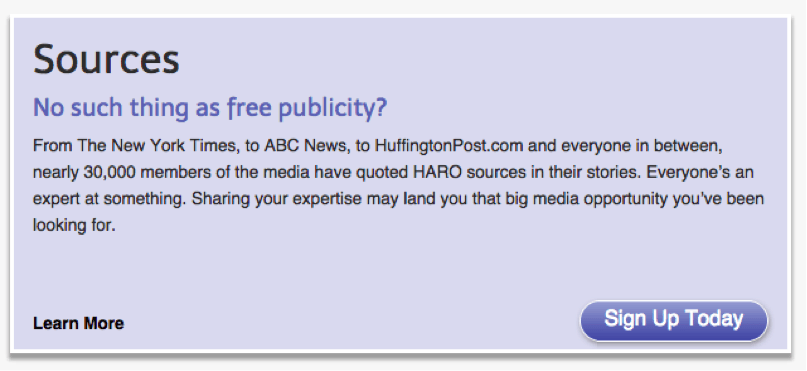As the author of thousands of blog posts, one question I often get is: How do you think of new ideas for blog posts?
I have had occasional writer’s block; but for the most part, coming up with ideas has never been an issue. If you pay attention to the world around you and listen to people, you’ll get a flurry of potential ideas for posts.
Also, there are tools and tricks that will help you find even more ideas.
I decided to compile a list, a complete list, of ways to come up with content ideas. These methods can be used to develop a blog post, an e-book, a podcast, or whatever you want to create.
Here is that list, with one caveat before we begin.
Content Ideation Secret: Questions
Before you start trying to brainstorm content ideas, it’s best to be in a problem solving frame of mind. You’re attempting to solve the problems and answer the questions your target readers have regarding your industry.
In other words, you are looking for questions. It could be questions people ask aloud, things they search for, or things they simply ponder in their minds.
I’m a golfer, and a question many golfers have is: How do I grip a golf club?
If an amateur golfer sees a title like How the Best Golf Pros Grip the Club, they have to click. It doesn’t matter if it’s on a search engine, on social media, in an email, or wherever. The title answers a question and solicits a click.
So start with the frame of mind that you’re going to answer questions with your content and with your content titles.
Now, let’s get into the sources of content ideas!
1. General Forums (Quora, Yahoo!, etc.)
One of the first places I go to find inspiration for titles is Quora. It’s a huge forum where people ask questions about everything under the sun. Simply type in the topic your readers are interested in or the name of your industry, and you will start finding questions that you can turn into content.
From this question, you could create something like: 10 Invoicing Tools for Freelancers
2. Industry-Specific Forums (Your Readers’ Forums)
Forums are kind of old school in the world of the Internet, but they’re still popular. They are one of the simplest ways for people to converse with others online just as they do in real life. People share news, ask questions, answer questions, and more.
There are general forums like Quora, but there also are forums for just about every industry and niche.
Go to Google and search for [your industry] forum, and you’ll likely find at least one and probably a dozen.
Here’s a snapshot from </dream.in.code>:
There are a few great questions on that one page.
3. Online Groups (Facebook, LinkedIn, etc.)
Social media groups are like niche forums. People discuss industries, interests, and topics. Look for the groups that don’t allow lots of article sharing. Those are mostly spam. Look for groups in your industry that have a lot of questions and answers.
4. Industry Publications: Popular Titles and Topics
Find the sites in your industry that publish all the latest news, trends, tips, and everything else your readers love. Look for the articles with the most engagement: comments, shares, views, etc.
You’ll get a feel for what’s popular and what the hot topics are. Create content on those topics, and try to either bring a different viewpoint or expand on what’s already been discussed.
5. Industry Publications: Comment Sections
On industry publication sites, you’ll see comments. The people leaving the comments are your target readers, so notice what they’re saying. Since writers do not, and cannot, share everything on a topic in a single article, sometimes readers will ask questions. Look for those questions, and provide answers with your own content.
6. Social Media: People You Follow
Create a list of your ideal readers. Usually, that’s a list of your best customers or ideal customers. Follow them, and take note of the content they engage with. See what they share, reply to, etc. Those are topics you can cover with your content.
7. Social Media: People Who Follow You
A basic social media strategy is to share the content you create (and the best content you can find) that your target audience will find interesting and useful. If you do a good job of this, you’ll attract a following.
Even with only a few followers, you can ask your followers questions like: What is your biggest challenge at work?
The replies can lead to great topics for content.
8. Social Media: Hashtags
It took me a while to start using hashtags on the updates I share on social media, and it took me even longer to follow hashtags.
Your ideal followers won’t always follow you. It’s just the way it is. But you can still find them by following popular industry hashtags.
Follow the hashtags and look for popular articles, buzzwords, and questions. That can lead to potential topics for your content.
9. Social Media: Questions People Ask Industry Influencers
Identify the influencers in your industry. Put them on a Twitter list or follow them. Look at how people interact with those influencers. Often, people will ask influencers questions; but because influencers are busy, they won’t have time to respond to all the questions.
That’s where you can step in and provide the answers.
10. Social Media: Topics Industry Influencers Discuss
Look at the things influencers are sharing. Create similar content. If it’s good enough for the influencers in your industry, then it’s important.
11. SlideShare
SlideShare kind of falls into its own category of online content. It’s a hugely popular site, and there are slide decks for just about every industry out there. Search for your industry, and find the most popular decks. From there, create content that builds on the popular topics or that presents your unique commentary.
12. YouTube: Industry Videos
There are a few ways you could get inspiration from YouTube. The one that works the best is to find the most popular videos from your industry, which could be how-to videos, trend videos, news videos, or whatever. Then look for those with views, comments, and other engagement, and you’ll have the topics you should be focusing on with your content.
13. Instagram Feeds and Comments
I’ve followed influencers in the online industry, and the comments they get can lead to content gold. Again, influencers don’t have time to answer every question. That’s where you can come in. And for some reason, influencers on Instagram get a lot of comments.
14. Interviews
Talk to interesting people. I like to think that everyone has a unique perspective to offer on something. Even if they’re just telling their own stories about experiences they’ve had, it can lead to inspiration for a post. So interview someone. Talk to them in person, on the phone, or over email. Ask them a few questions.
Use the discussion as inspiration. You also could use the interview as a piece of content, but always get permission before you do that.
15. External Roundups
A roundup can make a great post on its own. Provide ten great pieces of content for your customers to consume. In addition, looking through the content itself can spark inspiration. You can see what people like, and then form your own content.
16. Internal Roundups
This is the same basic idea as the external roundups described above, except that here you’ll look back through your own archives to see what you’ve done in certain categories or tags.
17. Surveys
Are you unsure about what your customers need to know? Ask them what they’re struggling with. Ask them for three challenges they’re facing in the industry. Ask them what topics they would like to know more about. Don’t overdo it with surveys. Directing even one question to a few customers can lead to great content inspiration and ideas.
18. Your Website: Comment Sections
In the same way you can get ideas from the comment sections of other websites, you can get great ideas from your own comment sections. If readers are asking questions or telling you what you should have included, you can use that to create new content.
19. Your Website: FAQ Sections
Many websites have frequently asked questions sections because they get repeat questions and want to provide the answers for visitors and new customers. Look at your FAQ section and determine if there are ways you can expand on the topics with another form of content, such as a video, a blog post, an e-book, or a guide.
20. Competitor Websites: FAQ Sections
Take a look at the FAQ sections on your competitors’ websites. See what questions they’re getting all the time, and make sure you’re answering those questions with some form of content.
21. Conference Q&A Sessions with Experts
Conferences are great if you can attend. Not only do you learn a lot, but you can use the sessions for content inspiration. You can pull inspiration from the topics the experts discuss. Also, pay close attention to the Q&A sessions and focus on what people ask. Can you provide answers to those questions?
22. Conference Agendas
Check out the agendas for conferences. See what the big topics are. You can create your own content based on the hot topics at conferences.
23. Conference Roundtable Discussions
I think there is good value in the roundtable discussions at conferences. The best discussion often comes from the questions. If people ask questions about the same topic, it’s a good indication that content covering that topic would be popular.
24. Customer Service Representatives
Here is one of my favorites. I used to work for a large shoe catalog company, and I would get the occasional email from customer service saying they were getting questions about the shoes.
I would try to find the answer and report back. But then I realized that customer service representatives speak with the customers all the time. They get a lot of business-specific questions, but they also get many general questions. Those general questions can lead to great ideas for content.
25. Salespeople
Like customer service representatives, salespeople are in constant communication with customers. They are on the front lines. Even better, salespeople work with customers in the early stages of the sales process. So they answer common questions all the time. You can take that insight and turn it into great content that will attract other potential customers.
26. Product/Service Experts
When I worked for the shoe company, I learned that the merchandisers would attend shoe shows where they would get all the latest information on upcoming trends. This made for great blog posts. We could do content about Hot Trends for Next Summer, and people liked it. The experts at your company often have very interesting and useful knowledge.
27. Popular Posts on Your Site
Look at the popular posts on your site, even going back a few years. You can create new content on the same topics or repurpose content into other forms like videos, podcasts, and more.
28. Announcements
What does your company have coming up? Big announcements can make for content that your customers would find interesting.
29. Webinars
Webinars have really become popular the last few years, but they’ve been around for a while. Check out the popular webinars in your industry. Look at the influencers. They usually hold webinars. Follow a few and see which ones are more popular. The topics discussed can make for great topics for all content.
30. An Industry Outsider
Have a discussion with someone who has little to no interest in your industry. They’ll likely have questions that would make for great content.
31. Webmaster Tools
All Google keyword search queries pass through Google’s Webmaster Tools now. It’s a good place to see what content is generating the most traffic from search. From there, you can look for other potential keywords that could be the focus of future content.
32. Website Analytics
The same tactic described in Webmaster Tools above works with analytics. You can see how visitors are finding your site. Then determine if there is more you can do in those channels to create content to attract more of the same type of visitors.
33. Google Search Box Suggestions
Notice the suggestions that appear when you start typing a search into the Google search box. Some of the suggestions can be ridiculous, but others can give you clues about what people are searching for.
34. Google Related Searches
On search results pages, look at the bottom and you will see related searches that can clue you in to what you could be covering in your content.
35. Controversy
What are the controversies in your industry? They don’t have to be life or death arguments, but find something that is a hot topic and start a conversation. Pick a side and create a piece of content around that idea.
36. HARO
Help A Report Out is great if you’re looking to be included in stories. You can also subscribe to see what the popular topics are in various industries. If you see trends, it’s a sign that you could be discussing the topic, too.
37. Popular Industry E-Newsletters
I try to subscribe to at least a handful of industry newsletters. I maintain the subscriptions to the good ones and replace the others. What I look for are the topics being discussed, and sometimes I get inspiration for something I can create that my target customers would find interesting.
One key: you’re looking at e-newsletters that your customers subscribe to.
38. Google Alerts
Set up alerts for certain topics that your customers care about. See what’s being published. Look for gaps in the information and create content to fill them.
39. Internal Data
Use the company data that you typically have about your industry and customers. It might be an old research project your team did or a collection of statistics you’ve gathered about your customers.
When the information is on a large scale, you can tell your customers things like “75% of our customers use X tool for analytics.” It’s anonymous but valuable to customers and potential customers.
40. Industry Statistics
Tap into industry statistics. I try to follow places like Nielsen, Emarketer, and others to see what the latest studies are showing in various industries. I can comment on the findings to create content.
41. Experiments
Experiments aren’t just for science class. Try experiments with your work. You can turn the experiment into a piece of content, or you could get inspiration for something you can create that your customers would find interesting.
42. Internal Website Search Queries
This goes with analytics a little bit (which was mentioned earlier), but I’m also calling it out as its own point. See what people are searching for on your site. If they’re not finding what they want, it’s a sign that you need to create content that provides the answer.
43. Popular Content Types from Other Industry Publications
Use popular content types, such as the Top Ten list from David Letterman. People love that format.
Maybe a popular site presents annual awards. You can create awards for your industry, its influencers, and best products and tools.
44. Content Topic Generators
There are a few content topic generators available. They use popular title formulas, and you fill in the blanks with your industry terms and keywords.
45. Self-Help Magazines
Self-help magazines are full of crazy titles. Simply add in your own industry’s words. Cosmo, Men’s Health, etc., all have extremely clickable titles.
46. Local News Broadcasts
The local news can have some hidden gems of information. They are great at finding stories that people find interesting and useful. I like it when they bring on local experts to share tips.
47. Local Business Networking Events
You know those happy hour events that chambers of commerce put on throughout the country? They can be great, but they can also be boring. To get more out of them, simply have conversations with a few people. Often, they’ll ask you questions about what you do, and those questions can inspire potential content for you to create.
48. Local Newspapers (Opinions, Letters to the Editor)
The stories in local newspapers are one thing, but I like the opinions and letters to the editor. These often point out things that someone wanted to know but didn’t get from the story or article. You can fill in the blanks with your own content.
49. Personal Mistake Analysis
Have you made mistakes? Who hasn’t?
Talk about a mistake you’ve made. These have been some of the most read posts on my own blogs.
50. Personal Success Analysis
Success works well, too. People like to read about more than just mistakes. We can all learn from stories about mistakes and successes.
51. Amazon’s Top Industry Book Lists
Check out the list for the top books in your industry on Amazon. If people are buying a book on a topic, you know they would be interested in a great blog post, guide, or podcast.
52. Your Forecasts for the Future
What do you think will happen in your industry in the future? Take twenty minutes to think about it. Break it down into different categories, and you’ll have yourself a few ideas for content to create. People are always looking for information to help them prepare for the future.
53. An Idea Notebook or Journal
Songwriters typically carry around notebooks where they write down random thoughts, lines, and ideas. These thoughts are later revisited to create entire songs.
There is no reason content creators can’t do the same. Start today by getting a notebook. Then, every day, add your thoughts for potential content ideas. Most of the ideas probably won’t work out, but you don’t need every idea to be a winner in order to succeed with content marketing.
54. Reddit
Reddit is a great tool. You can discover just about everything about everything on the site. See what people are sharing in your industry. Look for items with the most engagement. Those items are what you should be covering with your content.
55. Google News
Search for your industry on Google News. See what the latest articles discuss. Find hot trends and topics and look for a unique way to comment on them.
56. Trade Magazines
Trade magazines are incredibly popular with business professionals, including executives. They depend on these magazines for insight into what’s happening in the industry.
Pick up the magazines for your industry and see what the hot topics are right now. Offer your own commentary on the subjects.
57. Buffer
I love using Buffer. I take one day a week to add a week’s worth of social media updates to my Buffer, and then I sprinkle in updates when I can on top of it.
But, each week, I also look back on the updates that have been most successful. I can see what my followers care about and expand on those topics with new content.
58. Flipboard
People aggregate all kinds of content on Flipboard. Look for the influencers in your industry and see what they’re sharing. These are your clues to the topics your readers care about and that you should be covering.
59. Psychology Blogs/Magazines/Etc.
I’m a fan of psychology, but it wasn’t always that way. A few years ago, I started noticing that a lot of the blog posts and how-to videos I liked used studies as proof or to further a point.
If you follow popular psychology blogs, magazines, and other publications, you’ll find studies about all kinds of things. You can start entire content pieces from a study. You also can collect studies on a certain topic and make a very compelling piece of content.
Some of my favorite psychology blogs and magazines include:
There are many more.
60. Photo Sharing Websites (Flickr, Facebook, etc.)
You can gain inspiration from more than just text. Sometimes a photo can spark an idea. I like Flickr, but Facebook galleries can work, too.
61. Business Executives and Leaders
Business leaders almost always reach their positions because they know how to run a company and because they know what customers care about in the industry. Talk to the executives and leaders you know in your industry; for example, the CEO of your company. Invite them to lunch and discuss what’s happening in the industry. The ideas will flow.
62. Industry Regulating Organizations
Some industries are regulated more than others, but there usually are regulations to discuss in just about any industry. One thing customers care about is how a new regulation might affect them. Do some research, follow updates from regulating organizations, and provide commentary on what’s happening and how it affects your customers.
63. Headline Formulas (Similar to Self-Help Magazine Titles)
Sometimes you can start with a simple headline or title formula and work from there. This is like the self-help magazine titles. They all follow successful formulas. Just plug in your own terms.
- 30+ Ultimate Headline Formulas (Buffer)
- 10 Sure-Fire Headline Formulas That Work (Copyblogger)
- Steal These 15 Headline Formulas (Crazy Egg)
- Read this post as well: Can You Write a Better Headline than This?
64. Procedures and Systems
Look at the procedures and systems within your company. What you’ll find is that these systems can provide answers your customers wonder about, like How do you streamline cash flow?
There’s a procedure for that.
65. Competitor Websites (Answer Questions They Leave Unanswered)
I mentioned earlier that FAQ pages on competitor websites are a good source of questions to answer. Also look through the entire website of your competitor. Going through this process can spark inspiration for questions they leave unanswered.
66. Old Industry Advertising
Search for some old advertising in your company or google for old advertising in your industry. The way they sold things decades ago is probably different from today, and that can lead to content inspiration. Or you could collect 10 funny advertisements that would intrigue your customers.
67. Old Industry Manuals
Look at old industry manuals. They seemed to do a lot better with sketches and details back then. It wasn’t all just text. Those manuals can lead to inspiration as well.
68. Famous Quotes and Proverbs
Quotes are popular with people. We have them in our email signatures and on our office walls. Look for some new quotes to inspire you in general, and you’ll often find inspiration for content.
69. Famous Theories
Is there a famous theory in your industry? Maybe it’s an age old rule that everyone follows. See if you can create a new rule that is better than what everyone has been doing for the last few decades.
Or find a famous theorem from science, like the law of gravity, and apply it to your industry.
70. Industry Software Knowledge Bases
There is a lot of good information in knowledge bases. They’re often forums, but other times they’re collections of articles on how to do things. You can get content ideas from the articles; but if it’s also a forum, you can see what people are asking that isn’t found in the knowledge base. Then you can provide the answers.
71. Support Forums
See if there are support forums in your industry. Check out your competitor websites or look in your own support forum. Find questions and provide the answers.
72. Behind the Scenes
What is it like in your office or workplace? Tour everything yourself. You might get inspired once you get out of your comfort zone. You could even give your customers a glimpse behind the scenes with a few photos and stories.
73. How It’s Made
Go back and see how your product/service works. People like to see how things work so document the process and lay it out for your customers.
74. Customer Reviews
Do customers leave reviews for you? We mentioned that you can tap into customer service; but if you get reviews via email or on your website, it’s a great source of ideas for content.
Any questions your customers ask can lead to content, but also pay attention to the language your customers use. It might differ from the terms you use. Always use the terms your customers use when they’re discussing your industry and product.
In the shoe business, we had to figure out if customers used the word “loafer” more or less than “slip-on.” We looked in the reviews.
75. Your Company’s About Page
Often, we get caught up in the daily activities at our company. It’s easy to forget about its history, vision, and mission. Check out the About page and get some inspiration for a piece of content.
76. Sneak Peeks and Previews
Is something coming up at your company that you’re excited about? Provide a little glimpse into the future for your customers. It can build intrigue.
77. “You May Also Like…” Article Suggestions
Do you read the popular online publications like CNN and TIME? Most of these sites now have “You may also like…” suggestions. Check these out to see what publishers are promoting. Usually, they’re promoting their most popular or most important content, which can be clues to what people are interested in right now in your industry.
78. Competitor Email Signups and Newsletters
I mentioned industry email newsletters above, but now look at competitor newsletters. Specifically, look at the signup forms. See what the competition is offering in return for a signup. If it’s a guide or e-book, you can bet that it’s important, so you might want to create something similar (or even better).
79. Before and After Transformations
Has something changed at your company or within your industry? The change can make for a compelling story.
80. Difficult Decisions
What are the most difficult decisions your customers face in your industry? Find a few of these and discuss how your customers can make the decisions that are best for them.
81. Seemingly Obvious Situations (Can You Write about the Converse?)
Let’s say everyone is talking about the benefits of walking to work every day. It seems obvious that it’s beneficial, but what if you looked at the converse? Maybe it’s not healthy to walk to work every day. Maybe a bike is better. See if you can debunk some common practices.
82. Industry Myths
Look at things that your customers believe that they shouldn’t believe. Content like this can be good, but make sure you come prepared with research and examples.
83. Games
Games offer timeless lessons. You could probably get inspired from a game of Monopoly or Life.
84. Sports
Sports is another area that delivers valuable lessons. Playing a sport teaches you about many things in life. In my case, I’ve written posts that reference lessons I’ve learned while golfing.
85. Meditation
When your mind is focused on the present, you’re able to think of new things, things you weren’t thinking about before. That can lead to inspiration.
86. Challenge Yourself to Something
What is something that you’ve been wanting to accomplish? Challenge yourself to do it now. Document the experience for a piece of content.
87. Life-Changing Events
Things that change your life can make for great content. People like inspiring stories. Even if something negative happens, telling your story can help others going through similar situations.
And it doesn’t have to be about you. It could be something you’ve read or something a friend experienced.
88. Your Own Reviews
Look at a tool you’ve used recently or one you’ve been using for a long time. Write a review of it. Keep the focus on your customers, if possible. If things you’ve reviewed won’t help them, then get your hands on something that would and provide your thoughts.
89. Vacations
I know you’ll be on board with this one. Some of the best ideas I’ve had for blog posts have come when I was spending time on vacation. Being in a new place can spark inspiration. And when your brain is rested, you will think clearer than you do when you’re busy all the time with work.
90. Fiction
Fiction, any kind, can lead to inspiration. Fiction explores the common themes we experience in life; and in just about every piece of content, you’re exploring a common theme that affects someone.
91. Give Strangers Fake Backgrounds and Stories
I actually heard this on a TV show a few years ago. A person on the show was a screenwriter. He said he watched people in public places and imagined fake backgrounds for them. He would see a couple and imagine how they had met and what kind of work they did.
Thinking about people in this ways trains your brain to think in new ways, and that can help with the content you create.
92. Pets
Pets are weird, funny, and curious, and they don’t really care if you watch them. Watch how your pet acts. That can lead to inspiration. Also, the exercise of going for a walk with your pet or tossing a ball with them stimulates brain activity.
93. Wild Animals
Wild animals are interesting creatures. Watching birds, a pair of coyotes in a field, and even fish swimming around can get your brain inspired in unique ways.
94. Life Lessons
Those lessons your parents, family, and friends have taught you throughout life can lead to wonderful content. We love hearing the wisdom our elders have shared with us and with others.
95. Clichés
These are things that are so common we say them without even considering if they’re actually true or not. Think of the common sayings you’ve heard and see if you can come up with an argument against them.
96. Sketching
Sketching can actually improve your memory. When you’re trying to think of something to write about, your mind can wander. Sketching can focus your mind just enough to help you come up with a great idea for your new content. The activity also works different parts of your brain.
You could even use the sketch itself as the piece of content.
97. Film Dialogue
One of my favorite films is Rounders. The dialogue in that movie is wonderful. At one point, the main character states that the same five people make it to the final table in the World Series Of Poker every year. They’re not lucky. They’re the best, and they worked to get there.
Hearing that can lead to creating content about the theme of hard work or about dominating your niche.
Look at films for inspiration. Pay attention to the themes the characters discuss.
98. Song Lyrics
Music inspires just about everyone. Artists sing about all the emotions and situations we experience in life. If you’re in a rut with brainstorming, listen to music for a while. Get lost in the lyrics, and you may find a theme you can use for a piece of content.
99. Your Favorite Hobby
My favorite hobby is golf. I get inspiration from it in a few ways: conversations with fellow golfers, situations I find myself in, things that challenge me. When you step outside the areas where you commonly work, you can find inspiration that leads to new insight.
100. Family and Friends
Family and friends are your best support system. If you’re struggling with something, just ask them for their thoughts. See if they have questions. They want you to succeed, and they’ll be happy to get your brain working again. They can help you see something from a different point of view, and that can lead to better content.
101. Walk Outdoors
Writer’s block can put you in a bad mood. A bad mood won’t work for creating great content. Get outside and go for a walk.
You don’t believe me?
One study found that walking thirty minutes had a bigger impact on depression than anti-depressant medication. Another study found that the more steps a person takes, the better the mood they are in.
Phew! I’m exhausted. It’s a big list, but I’m sure I missed some ways to come up with content ideas that you have used. I would love to hear what you think of this list and what ideas I missed. Let’s chat in the comments!
About the Author: Dayne Shuda is the founder of Ghost Blog Writers, a blog writing services provider to businesses. Connect with him on Twitter.
















Comments (17)